Have you ever gotten frustrated in a brick-and-mortar store, then left your full shopping cart on aisle three before stalking back out to the parking lot? That’s why it’s important to collect as many abandoned cart email tips as possible.
Abandoned shopping carts happen online as well as in the store. The only difference is that your employees don’t have to restock the items.
An abandoned cart email helps bring back those customers so they can complete the checkout process and put cash in your pocket. But how do you write an abandoned cart email? That’s what we’ll cover today.
Abandoned Cart Email Statistics and Curious Facts
It’s important to know what you’re up against when it comes to abandoned shopping carts.
According to one study, the cart abandonment rate has risen to nearly 79 percent. People are most likely to abandon carts when they’re using their phones, but the numbers are high for tablets and desktop, as well.
Some sectors fare worse than others, such as travel and finance, but the rates are high across all industries. Knowing this, you need a plan to rescue abandoned carts.
What is an Abandoned Cart Email?
An abandoned cart email is an automated email that gets sent to a lead who has put items in his or her virtual shopping cart, but left the site without checking out. It reminds the consumer about the item or items and invites that shopper to return.
What is an Abandoned Cart Email Conversion Rate?
An abandoned cart email conversion rate refers to the percentage of consumers who receive these emails and convert on the opportunity to buy the neglected items.
According to a recent study, abandoned cart emails can recover up to 30 percent of lost sales. That’s the abandoned cart email conversion rate if 30 percent of the people who receive such emails return to the site and complete the checkout process.
Avoid People Abandoning Their Shopping Cart Using Hello Bar
Although you can always send an abandoned cart email (and I’m going to show you how), it’s easier to keep people from abandoning their items in the first place. A Hello Bar can help you reduce lost conversions and rescue revenue.
An exit popup can work well. After creating your Hello Bar exit popup, assign it to your checkout page specifically. That way, it doesn’t appear for people who are just reading your blog or browsing your product pages.
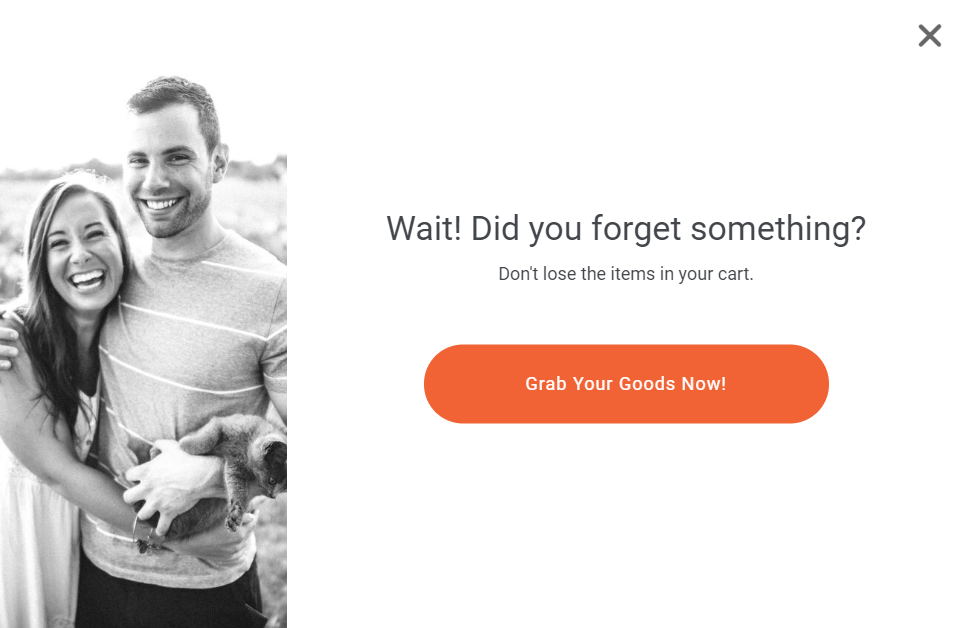
Your visitor might think twice about exiting out of your site. It’s the fear of missing out.
What are the Most Common Reasons People Abandon Their Shopping Carts?
According to research collected by Statista, people abandon shopping carts for many reasons. The top three are related to unexpected costs, the “just browsing” mentality, and finding a better price at another store.
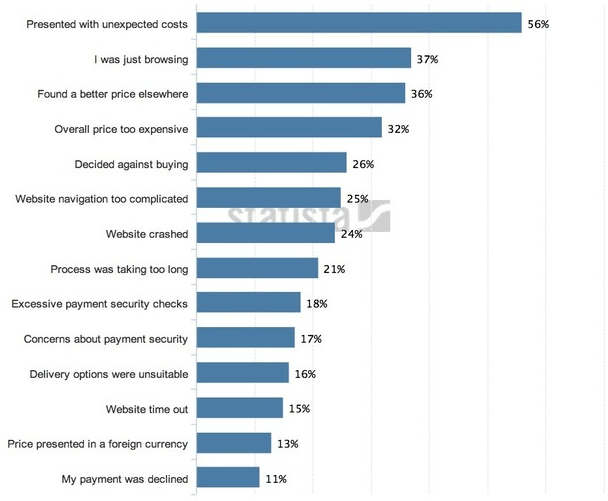
You can see from the list above that many of these issues are preventable. For instance, complicated website navigation, website timeouts, poor delivery options, and overlong checkout processes can be corrected on your end.
The 3 Basic Elements of an Effective Abandoned Cart Email
People will abandon their shopping carts no matter how perfectly you design your website. That’s just part of ecommerce marketing. But that doesn’t mean you can’t bring them back.
Ecommerce email marketing isn’t just about reaching out to your subscribers before they buy. It’s also an effective way to re-engage consumers who have interacted with your site, such as placing items in a shopping cart, without following through.
If you want to write an effective abandoned cart email, make sure your email has the following features.
1. Compelling Subject Line
The first hurdle is convincing your customer to open the email in the first place. Use compelling, urgent language without sounding too salesy.
Consider CTAs like these:
- Did you forget something?
- Are you still interested in [product name]?
- You left [product name] in your cart!
- Hey [Name], come back and see us!
They’re friendly, but not overly promotional.
2. Visual of the Abandoned Item(s)
Remember the old adage, “Show, don’t tell”? It applies when it comes to creating fantastic abandoned cart emails. You want your prospective customers to see what they’re missing.
Including a photograph or video of the item in the cart can help improve conversion rates. You’re engaging your prospect visually, which can result in an increased desire for the product in question.
If there are multiple items in the cart, you can choose to feature just one or show images of all of them. Make sure to include a compelling product description to go with the image(s).
3. Strong Call To Action
We talk a lot about calls to action here on the Hello Bar blog — and for good reason. They’re one of the most critical factors impacting conversions today.
Your CTA needs to tell your reader exactly what you want him or her to do. You get bonus points if the CTA also includes colorful or inviting language to draw in the reader.
Consider letting your CTA reflect your subject line, such as the examples I listed above. “Grab your goods” or “Don’t Miss Your Chance” work well. A/B test your CTAs to figure out which one works best in your abandoned cart email.
18 Best Abandoned Cart Email Strategy Tips That Will Increase Conversions
Writing an abandoned cart email is all about psychology. You want your prospect to do something that puts money in your pocket, so you have to think like a consumer.
What will convince your prospect to go back and complete the checkout process? What words, phrases, or images will prove sufficiently compelling to overcome all objections and questions?
Those are hard questions to answer, but I’m going to share with you my 18 best abandoned cart email strategy tips. Put them to use in your own ecommerce email marketing campaign to spark more conversions.
1. Make Your Abandoned Cart Emails Ultra Specific
Never waste your reader’s time, especially when you’re asking him or her to convert. Get right to the point in your email by asking the reader to return to the checkout page.
Include a brief headline, an image of the product(s), a brief description, and a call to action. That’s all you need. If you throw in too much copy, you’ll overwhelm the reader — and probably tank your chances of converting him or her.
2. Use Compelling Visual Features in Your Abandoned Cart Emails
Visuals help the reader connect to your message more effectively. You might use a stock image of a “sad” shopping cart, for instance. Just make it small so it doesn’t overwhelm the page.
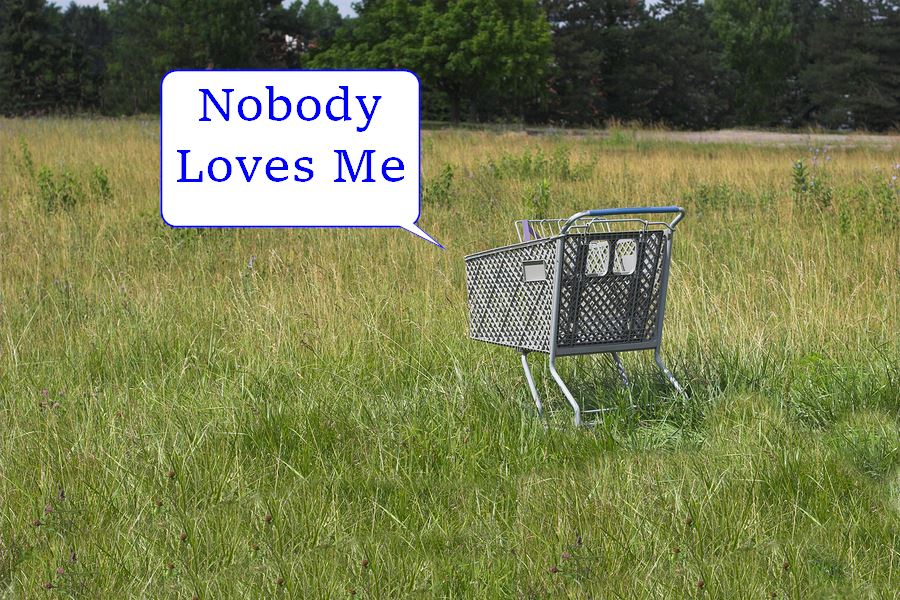
Images allow you to tap into your readers’ emotions. No, they don’t really care about a sad, lonely shopping cart, but the imagery inspires emotions like loss and disappointment.
Again, use product images, too. You want your reader to see what he or she is missing out on. Text alone won’t necessarily send your prospects running back to the virtual checkout line.
3. Use the Abandoned Items at the Start of the Email
A good way to prime your reader is to stick the image of the abandoned item and its description at the very top of the email. You can get to the details and CTA later.
Your reader will recognize the product. After all, he or she put it into the cart in the first place. That moment of recognition can inspire your reader to want the item again.
This doesn’t mean a headline can’t work, too. Test both strategies as you send out your abandoned cart emails to figure out which gets the most conversions.
4. Be Authentic and Clear — Remind People Of Your Brand Values
Staying true to your brand values and voice can make a huge difference in conversion rates. This is true with all marketing, but especially with abandoned cart emails.
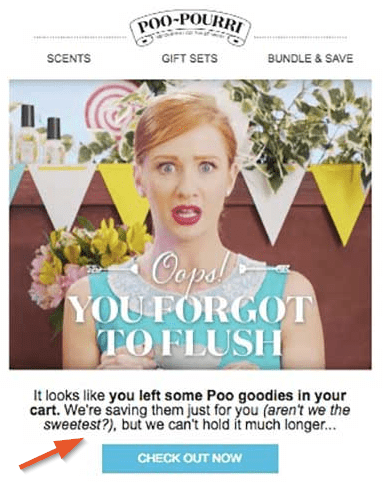
Add a dose of humor, use words that describe your brand (e.g. “sweetest”), and tell the truth (e.g. “we can’t hold it much longer…”). In other words, you want to remind people why they visited your site and added an item to their cart in the first place.
5. Address the Readers by Their Names
Personalizing your abandoned cart email can increase open rates as well as conversion rates. You want your reader to feel respected and appreciated.
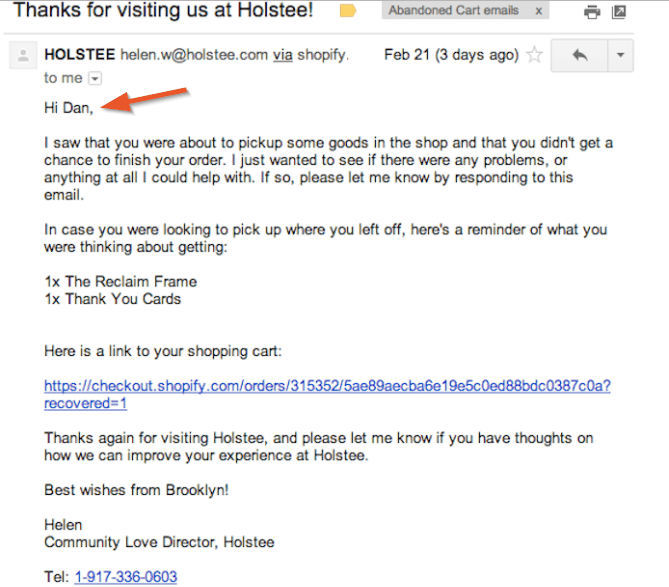
Consider addressing him or her by name in both the subject line and the actual email body. It’s a great way to establish rapport.
6. Appreciate the Reader For Adding Your Products to Their Shopping Carts
Gratitude goes a long way toward convincing someone to purchase something they’ve already abandoned. Thank the reader sincerely for both visiting your website and for selecting items from your inventory.
You don’t have to gush. A simple sentence or two will work just fine: “Thanks so much for visiting [Company Name] and adding [Product Name] to your cart. We appreciate your interest!”
7. Show the Reader How Unique Your Product Is and Why They Should Buy It
I mentioned earlier that people abandon their shopping carts for myriad reasons. Unfortunately, it’s impossible to know why one particular customer abandoned a cart.
Consequently, you have to position your product in the best possible light. Focus on communicating value, ease of use, uniqueness, affordability, or quality. Of course, you can mix and match as you please.
The important thing is to give the reader a reason to reconsider the abandoned items. If you’re persuasive enough with your copywriting, you’ll generate far more conversions.
Look through some product descriptions on an ecommerce site you like. Read what the companies highlight about the product, then use that information to inform your email copywriting decisions.
8. Offer An Incentive in Your Abandoned Cart Emails
Another way to improve conversions on abandoned cart emails is to provide an additional incentive.
It could be a discount code, an offer for free shipping, a bundle deal, or anything else that adds more value to the transaction.
9. Use Customers Reviews and Testimonials in Your Abandoned Cart Emails
There’s nothing wrong with a little horn-tooting if it’s warranted. People often make decisions based on what other people have said about a product or service.
Again, put yourself in the customer’s shoes. If you’re shopping for a product on Amazon and you see the following two user rating stats, which one would you be more willing to buy?
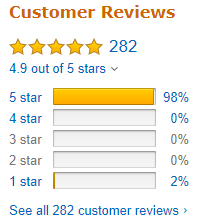
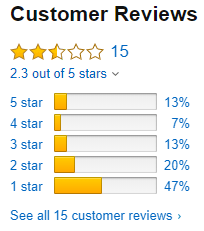
The first one, right? Not only does it have far more reviews, but it has a 4.9-star rating. The second only gets 2.3 stars.
Add reviews, testimonials, and other examples of social proof in your emails. Make sure they’re specifically about the product in question — otherwise, they’re useless.
10. Show Related Products and Wishlist Items in Your Abandoned Cart Emails
Maybe your prospect found a product he or she liked, but it just wasn’t quite right. You’ve had that experience before, I’m sure, so you can probably relate to the consumer in question.
Adding related products and highlighting wishlist items can help your reader decide to commit. For instance, maybe you have an upgraded form of the product your customer put in the cart. Suggest that product as an alternative because of X, Y, and Z extra features.
11. Use Humor in Your Abandoned Cart Emails If Appropriate
Some brands build their reputations on humor and a light, frothy approach to marketing. Others are more serious and prefer to leave humor out of the equation.
Only you can make that decision.
Often, you have to consider the customer. If there’s a chance your prospect might get offended or irritated by your stab at humor, resist the urge to be funny. If you think you’ll get a laugh, however, go ahead and unleash your inner comedian.
12. Send Your First Abandoned Cart Email Soon After the Abandonment
Timing matters when it comes to an abandoned cart email. If too much time lapses, your prospect has likely purchased the product from another vendor or decided against the purchase entirely.
Ideally, you don’t want more than 24 hours to lapse from the time your prospect abandons the shopping cart and the time you send your email. You watch to catch that person before he or she can go to the competition or think of more objections to the purchase.
13. Use a Sequence of Automated Emails to Increase Cart Recovery Chances
Email drip campaigns work extremely well when it comes to ecommerce marketing. They’re particularly useful when you’re leading up to a major call to action, such as returning to a full shopping cart.
Plan a sequence of three to five emails, each sent the day before the last. You don’t want to get on your prospect’s nerves, which could eliminate the chances of him or her returning to your site in the future. At the same time, you want to give that person every opportunity to convert.
In each email, highlight something new about the product in question. If you talk about value and quality in the first one, mention unique features in the second.
Your last one or two emails should include some type of incentive. You might offer a coupon or discount code, for instance, or offer free shipping no matter the cost of the order.
14. Segment Your Email Sequences
Segmenting your abandoned cart emails can help increase your conversion rate even further. You want the message to align with the customer’s position in the sales funnel.
Use one segment for people who have never visited your site before. They might have stumbled across it during a Google search, added a product to the shopping cart, and decided against it.
Take this opportunity to introduce your brand in more detail. Invite the reader back to your site to reconsider the purchase.
You might create another segment for people who already subscribe to your newsletter. They’re brand-aware, so you can dig right into the conversion CTA. Mentioning their subscription might also help boost conversions.
Finally, maintain another sequence or single email for people who have already converted on other offers. If they’re existing customers, you might ask how they enjoyed their last purchase and invite them to return.
15. Make it Super Easy For Your Customers to Go Back to Your Checkout Page
Simplicity can’t be underestimated when it comes to sending emails about abandoned shopping carts. If you complicate the process at all, most prospects will simply disregard the invitation.
Eliminate friction at every opportunity. For instance, let your customers check out as guests. That way, they don’t have to fill in a bunch of form fields, confirm their email addresses, and perform other tasks.
Additionally, your CTA should link directly to the user’s actual cart. Don’t make your prospect hunt for it — many won’t bother.
16. Constantly Test Your Emails and Calls to Action to Find Out What Works Best
Test, test, test. Just when you think you couldn’t test anything else, find something new.
At Hello Bar, we recommend A/B testing everything, regardless of what you’re offering on your website. Do the same with your emails.
17. Create Urgency Using a Countdown In Your Abandoned Cart Emails
A countdown is a great way to convey urgency. If the timer runs out, your website will automatically empty the user’s shopping cart.
People have a fear of missing out. They don’t want to lose something that’s within their grasp, so if they have any desire for your product, they’ll convert. The countdown timer serves as a visual reminder that your prospect doesn’t have all the time in the world.
18. Make Sure Your Emails Are Mobile Friendly
Earlier in this article, I mentioned that abandoned shopping carts are far more common on mobile devices than on desktop. Consequently, you need your website as well as your email to be mobile friendly.
Use responsive design on your website and make sure your images are properly scaled in your emails. Don’t use a subject line that the reader can’t see on a mobile device, and avoid using heavy backgrounds or other elements that might slow email loading times.
Abandoned Cart Email Examples
Now that you’re familiar with my 18 best tips for writing abandoned cart emails, let’s look at some excellent examples that might inspire you.
The first comes from Amazon, which is arguably one of the best at boosting ecommerce conversions.
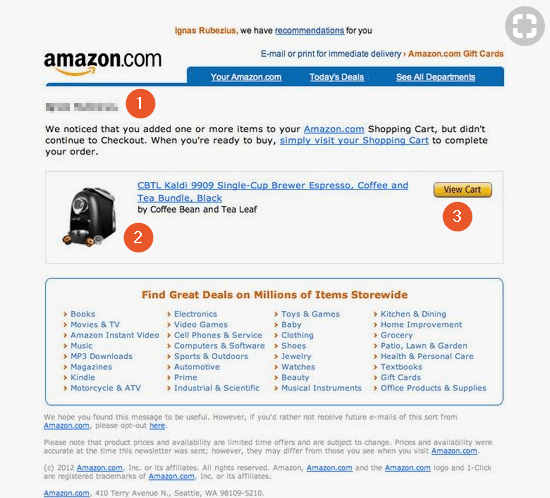
You can’t see it because I’ve blurred it out, but the email starts with the customer’s name. That’s a great way to personalize the email.
Amazon has included a photograph of the product abandoned in the cart, then included a clear and obvious CTA for the customer to “View Cart.” Although it’s not particularly inspired in terms of creativity, it gets the job done.
Next, we have an example from Wilderness Explorers.
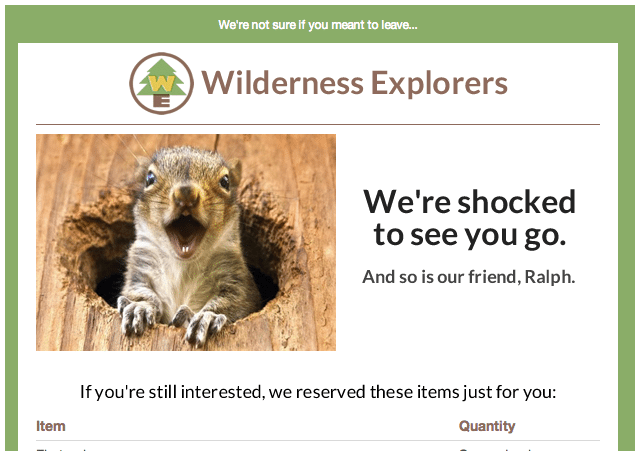
This is a prime example of an abandoned cart email done well with humor and brand authenticity. We have the cute photo, the humor in the headline, and the personalization with the phrase “just for you.” Although it’s cropped, the email also lists the items in the shopping cart so the reader can go back and grab them.
Conclusion
An abandoned cart email, in many cases, represents cash in your pocket. It’s that important.
People abandon their virtual shopping carts for lots of reasons. They get distracted, change their minds, come up with questions or objections, or simply decide they’ll come back later.
Whatever the case, your email might draw them back to your site and give them an excuse to follow through with the purchase.
Some brands have experienced conversion rates of up to 30 percent using abandoned cart emails. If that’s not an incentive to try them, I don’t know what is. Bringing back that much business can have a huge impact on your bottom line.
Remember that you have to make it easy for the customer. Make a compelling case for buying the item or items in question, then show them exactly how to return to their cart and complete the checkout process.
Using tactics like urgency, discounts, and free shipping can help. It’s also essential to test your emails so you know what works and what doesn’t.
Do you use abandoned cart emails for your business?
